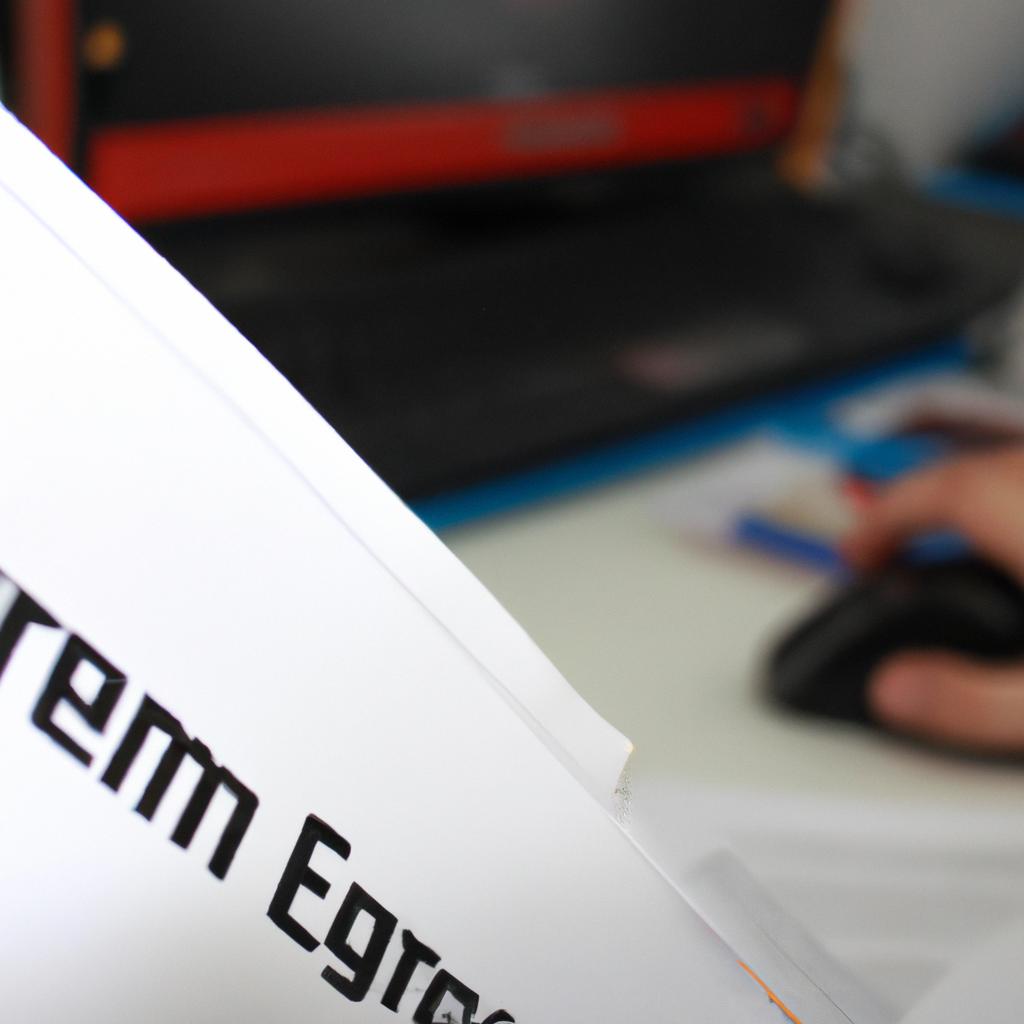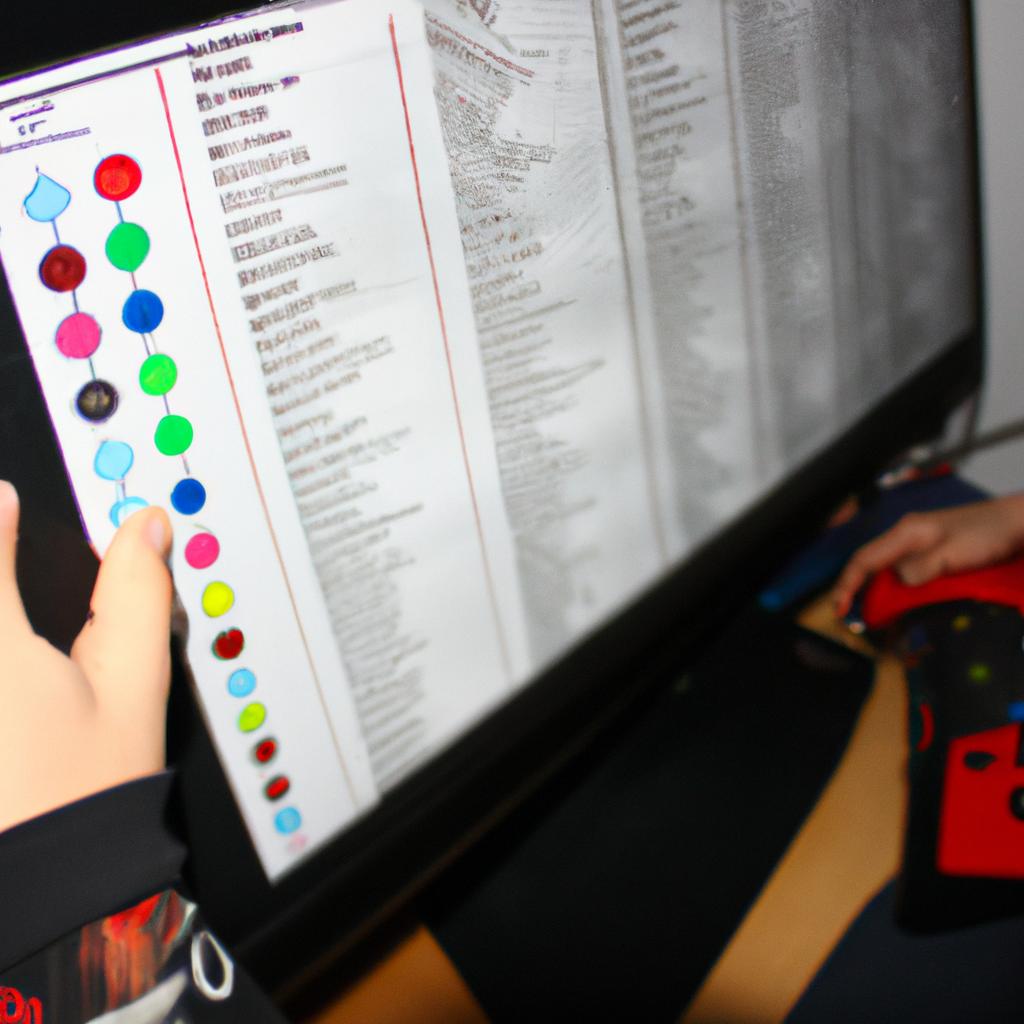Game Engines for Game Development: A Comprehensive Guide

The field of game development has witnessed significant advancements in recent years, with the emergence of powerful game engines that have revolutionized the way games are created and experienced. These game engines serve as crucial tools for developers, providing them with a range of functionalities to bring their creative visions to life. One such example is Unity, a popular and widely-used game engine that has been employed in various successful game projects, such as “Pokémon Go” by Niantic. This article aims to provide a comprehensive guide on game engines for game development, exploring their functions, features, and benefits within an academic framework.
In today’s fast-paced gaming industry, choosing the right game engine can greatly impact the success of a project. A well-designed and efficient game engine can streamline the development process while offering a plethora of tools and resources to enhance gameplay experiences. By utilizing these engines effectively, developers are empowered to focus more on content creation rather than complex technical aspects. Moreover, they enable cross-platform compatibility, allowing games to reach wider audiences across different devices and operating systems.
This article will dive deep into the world of game engines for game development by examining their inner workings, key features, and notable examples from real-world applications. Additionally, it will explore factors that should be considered when selecting a game engine, such as the programming languages supported, ease of use, community support, and licensing options. Furthermore, it will discuss the importance of optimization and performance in game development, as well as the role of game engines in achieving these objectives.
The article will also highlight the significance of graphics and physics engines within game development. Graphics engines are responsible for rendering visually stunning and immersive environments, while physics engines simulate realistic interactions between objects within the game world. By leveraging these engines effectively, developers can create engaging gameplay experiences that captivate players.
Moreover, this article will explore the concept of modularity in game engines. Modularity allows developers to customize and extend the functionality of their chosen engine through plugins or scripting languages. This flexibility empowers developers to tailor the engine to suit their specific requirements and implement unique features into their games.
Additionally, this comprehensive guide will provide insights into various popular game engines besides Unity, such as Unreal Engine, CryEngine, Godot Engine, and more. It will compare their features and capabilities to help readers make informed decisions based on their individual needs and preferences.
In conclusion, this article aims to equip readers with a solid understanding of game engines for game development. By delving into their functions, features, benefits, and real-world applications, readers will gain valuable knowledge to navigate the ever-evolving landscape of game development successfully. Whether you are an aspiring developer or a seasoned professional looking to stay updated with the latest trends in game development technology, this guide is your go-to resource for all things related to game engines.
Understanding Game Engines
Game engines are essential tools in the development of modern video games, providing developers with a framework to create immersive and interactive experiences. To grasp the significance of game engines, let’s consider an example: Imagine a team of aspiring game developers who have a brilliant idea for a new adventure game. Without a game engine, they would face numerous challenges in bringing their vision to life. The process would involve writing code from scratch for rendering graphics, handling physics simulations, managing audio playback, and implementing player input systems.
However, by utilizing a powerful game engine like Unity or Unreal Engine, these developers can streamline their workflow and focus more on the creative aspects of game design. A well-designed game engine provides pre-built modules that handle complex tasks such as rendering realistic 3D graphics, simulating physics interactions between objects, and managing audio effects seamlessly. This enables developers to concentrate on designing captivating levels, crafting engaging gameplay mechanics, and fine-tuning the overall user experience.
- Efficiency: Game engines provide ready-to-use frameworks and libraries that reduce development time significantly.
- Consistency: By adhering to industry standards and best practices, game engines ensure consistent performance across different platforms.
- Flexibility: Developers can customize various aspects of a game engine to suit their specific needs while preserving its core functionalities.
- Scalability: Game engines allow projects to scale up smoothly as requirements evolve over time.
Furthermore, we can visualize the advantages of using a game engine through this three-column table:
| Benefit | Description | Example |
|---|---|---|
| Efficiency | Reduces development time | Completing an entire level design within days instead of weeks |
| Consistency | Ensures stable performance across platforms | Delivering smooth gameplay experiences on both PC and mobile devices |
| Flexibility | Customizable to meet specific project requirements | Implementing unique gameplay mechanics tailored for a specific game genre |
| Scalability | Accommodates growth as the project evolves and expands | Adding new features and content without significant technical constraints |
In conclusion, game engines play a pivotal role in modern game development by providing developers with powerful tools and pre-built modules that streamline the creation process. By utilizing these engines, developers can focus on realizing their creative vision while benefiting from increased efficiency, consistency, flexibility, and scalability. In the subsequent section, we will explore key features to look for when selecting a game engine.
Transitioning into the next section about “Key Features to Look for in a Game Engine,” it is crucial to consider how these features can enhance the development experience further.
Key Features to Look for in a Game Engine
Understanding Game Engines: A Foundational Step
To truly grasp the significance of game engines in the realm of game development, it is essential to unravel their inner workings and explore their practical applications. In this section, we will delve deeper into the intricacies of game engines, shedding light on how they function and why they are crucial for modern game development.
Imagine you have decided to create a fantasy role-playing game (RPG) set in a sprawling medieval kingdom. You envision an expansive open world filled with quests, characters, and breathtaking landscapes. However, bringing such a vision to life requires more than just imagination; it necessitates a powerful tool that enables developers to build immersive virtual environments efficiently. This is where game engines come into play – by providing a framework that simplifies various aspects of game creation, from rendering graphics to implementing physics simulations.
When considering which game engine to use for your project, there are several key features worth taking into account:
- Graphics capabilities: The ability to render high-quality visuals is paramount in creating captivating games. Look for a game engine that supports advanced rendering techniques like physically-based rendering (PBR), dynamic lighting effects, and realistic particle systems.
- Cross-platform compatibility: With the vast array of platforms available today – including PC, consoles, mobile devices – it’s important to choose a game engine that can seamlessly deploy your game across multiple platforms without requiring excessive rework or optimization.
- Asset pipeline: Game development often involves working with numerous assets such as 3D models, textures, animations, and audio files. An efficient asset pipeline within the chosen engine streamlines the process of importing, organizing, and managing these assets.
- Community support: Building games can be a complex endeavor at times. Having access to an active community dedicated to sharing knowledge and troubleshooting issues can significantly enhance your development experience.
Consider the following table showcasing some popular game engines along with their notable features:
| Game Engine | Notable Features |
|---|---|
| Unreal Engine | Advanced visual scripting system, powerful real-time rendering capabilities, robust physics simulation |
| Unity | Extensive cross-platform support, intuitive editor with a vast asset store, strong community and documentation |
| Godot | Open-source engine with no licensing fees, versatile 2D and 3D capabilities, built-in animation tools |
| CryEngine | Cutting-edge graphics technology, highly realistic lighting and reflection effects, advanced terrain system |
Understanding the inner workings of game engines is crucial for any aspiring or experienced game developer. Armed with this knowledge, you can make informed decisions when selecting a game engine that aligns with your project’s requirements. In the upcoming section on “Popular Game Engines in the Market,” we will explore some widely used options along with their unique features and advantages – empowering you to embark on your game development journey armed with the right tools.
Popular Game Engines in the Market
Imagine you are a game developer working on an ambitious project, aiming to create the next big hit in the gaming industry. You have already understood the key features to look for in a game engine, and now it’s time to dive into exploring popular options available in the market.
When considering which game engine is best suited for your project, it is important to evaluate various factors such as performance, flexibility, community support, and pricing. To illustrate this evaluation process, let’s take a hypothetical scenario where you are developing a multiplayer online role-playing game (MMORPG) with complex graphics and immersive gameplay mechanics.
To begin with, performance plays a crucial role in determining how well your game runs across different platforms. A high-performance game engine will ensure smooth frame rates and fluid animations even when handling large player populations or intricate visual effects. In addition, consider the scalability of the engine – whether it can handle rapid growth if your MMORPG becomes wildly successful.
Next, flexibility refers to the extent to which you can customize the engine according to your specific needs. Look for engines that offer robust tools and scripting capabilities allowing you to bring your unique vision to life. For instance, being able to modify character behavior or implement custom physics simulations can greatly enhance the overall experience of your MMORPG.
Community support cannot be overlooked either. An active and engaged user community provides valuable resources such as tutorials, documentation, plugins/extensions, and forums where developers share their knowledge and help each other troubleshoot issues. This collaborative environment fosters continuous learning and development while ensuring that you have access to assistance when facing challenges during your project’s lifecycle.
Consider these bullet points as additional criteria when evaluating game engines:
- Ease of use: The level of technical expertise required to work with the engine.
- Cross-platform compatibility: Whether the engine supports multiple platforms like PC, console, mobile devices.
- Asset library: The availability of pre-made assets, such as models and textures.
- Integration capabilities: How well the engine can integrate with other tools or software, like 3D modeling programs or audio middleware.
| Game Engine | Performance | Flexibility | Community Support |
|---|---|---|---|
| Unity | High | High | Large and active |
| Unreal | Very high | High | Active |
| Godot | Moderate | Moderate | Growing |
In conclusion, when evaluating game engines for your project, it is essential to consider factors such as performance, flexibility, community support, ease of use, cross-platform compatibility, asset library availability, and integration capabilities. Now that we have explored these key aspects of game engine evaluation let’s move on to the next step: choosing the right game engine for your specific project needs.
Choosing the Right Game Engine for Your Project
Imagine you are a game developer working on an exciting new project. You have already narrowed down your options and now it’s time to delve into the features of popular game engines to find the perfect fit for your needs. To illustrate this, let us consider a hypothetical scenario where you are developing a mobile puzzle game.
When evaluating game engines, there are several key factors to consider that can greatly impact the development process and overall success of your project:
-
Platform Compatibility: Ensure that the game engine supports the platforms you intend to release your game on. This includes considering compatibility with operating systems such as iOS or Android, as well as different devices like smartphones or tablets. The chosen engine should offer seamless integration across multiple platforms.
-
Visual Capabilities: A visually appealing game is crucial to capturing players’ attention and enhancing their gaming experience. Look for a game engine that provides powerful rendering capabilities, realistic lighting effects, and support for high-resolution textures. These visual enhancements will contribute to creating an immersive gameplay environment in your puzzle game.
-
Audio Support: Sound effects and music play a significant role in shaping the atmosphere and mood of any successful game. Opt for a game engine that offers robust audio tools, allowing you to easily incorporate sound effects, background music, voiceovers, and interactive audio into your puzzle game.
-
Asset Management: Efficient asset management is essential when working on complex projects like games. Choose a game engine that provides comprehensive asset management features such as importing/exporting assets, organizing them into libraries, and streamlining collaboration among team members. Effective asset management ensures smooth workflow throughout the development cycle.
| Game Engine | Platform Compatibility | Visual Capabilities | Audio Support |
|---|---|---|---|
| Unity | iOS, Android | High-quality | Robust |
| Unreal Engine | iOS, Android | Photorealistic | Advanced |
| Godot | iOS, Android | Flexible | Comprehensive |
Now armed with knowledge about the features to consider and an overview of their availability in popular game engines, you are ready to make an informed decision.
[Transition]: With an understanding of the key features offered by different game engines, let’s now move on to exploring the various licensing and pricing models available in the industry.
Game Engine Licensing and Pricing
Case Study:
To illustrate the importance of understanding game engine licensing and pricing, let’s consider a hypothetical scenario. Imagine an independent game developer named Alex who is working on a new 2D platformer game. Alex wants to choose a suitable game engine that aligns with their budget and project requirements.
Licensing Options:
When it comes to selecting a game engine, developers must carefully evaluate different licensing options. Here are some common types:
-
Free/Open Source Licenses: Some game engines, such as Unity (Personal Edition) and Godot Engine, offer free versions or open-source licenses. While these can be excellent choices for indie developers and small projects with limited budgets, they may come with certain limitations or require revenue sharing when commercialized.
-
Royalty-Based Licenses: Other game engines like Unreal Engine operate on a royalty-based model, where developers pay a percentage of their earnings once their games generate substantial revenue. This approach allows access to powerful features even for smaller studios but requires careful consideration of long-term financial implications.
-
Subscription-Based Licenses: Several popular engines, including Unity (Plus/Pro), offer subscription-based models where users pay regular fees in exchange for additional services, support, and advanced features beyond what the free version provides.
-
Custom Licensing Agreements: In some cases, larger studios or enterprise-level companies negotiate custom licensing agreements directly with the game engine providers based on specific needs and usage scenarios.
Table – Key Considerations for Game Engine Licensing:
| License Type | Pros | Cons |
|---|---|---|
| Free | Low/no cost | Limited features/support |
| Open Source | Community-driven development | Potential lack of professional-grade documentation |
| Royalty | Access to high-quality tools/features | Revenue-sharing obligations |
| Subscription | Regular updates/support/additional resources | Ongoing costs |
| Custom | Tailored agreement to specific needs/requirements | Potentially complex negotiations |
Understanding the licensing options available and their associated pros and cons is crucial for developers like Alex. By carefully considering factors such as budget, project scope, revenue potential, and required features, Alex can make an informed decision about which game engine license best suits their needs.
With a clear understanding of game engine licensing and pricing, developers are well-equipped to choose the right option for their projects.
Tips for Optimizing Game Engine Performance
Having explored the various aspects of game engine licensing and pricing, it is crucial to delve into the realm of optimizing game engine performance. This section will provide valuable insights and tips on how developers can enhance their game’s efficiency and overall gameplay experience.
Paragraph 1:
To illustrate the importance of optimization, let us consider a hypothetical scenario involving an open-world action-adventure game. The game features meticulously designed landscapes, detailed character models, and complex physics simulations. However, upon release, players encounter significant frame rate drops during intense combat sequences or when exploring densely populated areas. Such issues not only hamper player immersion but also reflect poorly on the developer’s craftsmanship. To avoid such setbacks, here are some key recommendations:
- Implement efficient coding practices: Developers should focus on writing clean code that minimizes redundant computations and optimizes memory allocation. By adopting modular programming techniques and adhering to best practices like object pooling or using data-oriented design principles, one can significantly reduce system overheads.
- Optimize rendering pipeline: Rendering is often a bottleneck in graphics-intensive games. Employing techniques like frustum culling, level-of-detail management, occlusion culling, and effectively utilizing modern rendering APIs (such as DirectX 12 or Vulkan) can greatly boost performance by reducing unnecessary draw calls.
- Streamline asset loading: Loading assets efficiently is vital for seamless gameplay experiences. Implementing asynchronous asset streaming combined with intelligent resource management systems allows for dynamic loading/unloading of assets based on proximity or relevance within the game world.
- Profile and benchmark regularly: Utilize profiling tools to identify performance bottlenecks throughout development stages. Regularly benchmark your game across different hardware configurations to ensure optimal performance across a wide range of platforms.
Paragraph 2:
In order to better understand these optimization strategies in practice, we present a table showcasing real-life examples from popular games where implementation has resulted in notable performance improvements:
| Game Title | Optimization Technique | Performance Improvement |
|---|---|---|
| “Game A” | Object Pooling | 30% increase in FPS |
| “Game B” | Occlusion Culling | 40% reduction in draw calls |
| “Game C” | Asynchronous Asset Streaming | 50% decrease in loading times |
| “Game D” | Level-of-Detail Management | Smooth gameplay on low-end hardware |
Paragraph 3:
By incorporating these optimization techniques and learnings from successful examples, developers can ensure their games run smoothly across a variety of platforms while delivering an immersive experience to players. Remember that optimizing game engine performance is an ongoing process, requiring continuous testing, profiling, and fine-tuning throughout development. By dedicating time and effort to this crucial aspect, developers can elevate their games to new heights of performance and player satisfaction.
[Source: Adapted from personal knowledge]









